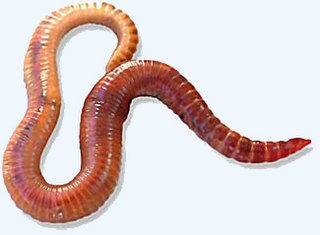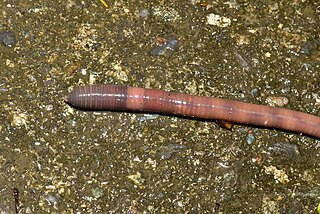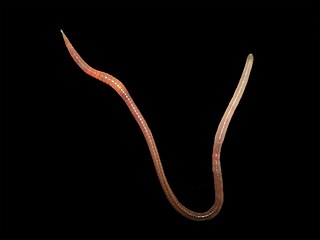Related Research Articles

The Lumbricidae are a family of earthworms. About 33 lumbricid species have become naturalized around the world, but the bulk of the species are in the Holarctic region: from Canada and the United States and throughout Eurasia to Japan. An enigmatic species in Tasmania is Eophila eti. Currently, 670 valid species and subspecies in about 42 genera are recognized. This family includes the majority of earthworm species well known in Europe and Asia.

Oligochaeta is a subclass of animals in the phylum Annelida, which is made up of many types of aquatic and terrestrial worms, including all of the various earthworms. Specifically, oligochaetes comprise the terrestrial megadrile earthworms, and freshwater or semiterrestrial microdrile forms, including the tubificids, pot worms and ice worms (Enchytraeidae), blackworms (Lumbriculidae) and several interstitial marine worms.

Megascolecidae is a taxonomic family of earthworms native to Madagascar, Australia, New Zealand, Southeast Asia, and North America. All species of the Megascolecidae belong to the Clitellata class. The Megascolecidae comprise a large family of earthworms and they can grow up to 2 meters in length. The intercontinental distribution of Megascolecidae species favours the continental drift theory.

Eisenia fetida, known under various common names such as manure worm, redworm, brandling worm, panfish worm, trout worm, tiger worm, red wiggler worm, etc., is a species of earthworm adapted to decaying organic material. These worms thrive in rotting vegetation, compost, and manure. They are epigean, rarely found in soil. In this trait, they resemble Lumbricus rubellus.

The Clitellata are a class of annelid worms, characterized by having a clitellum – the 'collar' that forms a reproductive cocoon during part of their life cycles. The clitellates comprise around 8,000 species. Unlike the class of Polychaeta, they do not have parapodia and their heads are less developed.
The Eudrilidae are a family of earthworms, mostly of Africa. One species, Eudrilus eugeniae, is widely distributed around the warmer parts of the world and historically cultured as the "African nightcrawler".
The Acanthodrilidae are an ancient and widely distributed family of earthworms which has native representatives in Australia, New Zealand, South Africa, South America, and North America. No native species are known from India nor Asia. The family possibly shows a pre-Pangaean distribution.
Diplocardia is a genus of North American earthworms with 52-57 known species that is remarkably similar to Australian Diplotrema Spencer, 1900.
Eisenia andrei is a close relative of the 'brandling' or 'tiger' worm Eisenia fetida. Like E. fetida, it is epigeic, i.e. it prefers to live in compost or leaf litter rather than mineral soils.

An earthworm is a soil-dwelling terrestrial invertebrate that belongs to the phylum Annelida. The term is the common name for the largest members of the class Oligochaeta. In classical systems, they were in the order of Opisthopora since the male pores opened posterior to the female pores, although the internal male segments are anterior to the female. Theoretical cladistic studies have placed them in the suborder Lumbricina of the order Haplotaxida, but this may change. Other slang names for earthworms include "dew-worm", "rainworm", "nightcrawler", and "angleworm". Larger terrestrial earthworms are also called megadriles as opposed to the microdriles in the semiaquatic families Tubificidae, Lumbricidae and Enchytraeidae. The megadriles are characterized by a distinct clitellum and a vascular system with true capillaries.
Rhinodrilus fafner is a presumed extinct giant earthworm from the family Glossoscolecidae. It is only known by the ill-preserved holotype discovered in 1912 near Belo Horizonte in the Brazilian state of Minas Gerais and described in 1918 by German zoologist Wilhelm Michaelsen (1860–1937) from the National History Museum in Hamburg. The collected individual has a length of 210 centimetre and the body which consists of 600 single segments is 24 millimetre in diameter. Along with Amynthas mekongianus and Megascolides australis, Rhinodrilus fafner is among the largest known giant earthworms. Rhinodrilus fafner was confined to a small habitat and vanished possibly due to habitat destruction. It was officially declared extinct by the Brazilian Ministry of Environment (MMA) in 2003. However, the rediscoveries of the Giant Palouse earthworm in 2005 and the Brazilian earthworm Fimoscolex sporadochaetus in 2007 created hope that Rhinodrilus fafner may be found again.

Invasive species of earthworms from the suborder Lumbricina have been expanding their range in North America. Earthworms are considered one of the most abundant macroinvertebrates in the soil of ecosystems in temperate and tropical climates. There are around 3,000 species known worldwide. They are considered keystone species in their native habitats of Asia and Europe because, as detritivores, they alter many different variables of their ecosystem. Their introduction to North America has had marked effects on the nutrient cycles and soil profiles in temperate forests. These earthworms increase the cycling and leaching of nutrients by breaking up decaying organic matter and spreading it into the soil. This thins out the soil rapidly because earthworms do not require a mate to reproduce, allowing them to spread fast. Since plants native to these northern forests are evolutionarily adapted to the presence of thick layers of decaying organic matter, the introduction of worms can lead to a loss of biodiversity as young plants face less nutrient-rich conditions. Some species of trees and other plants may be incapable of surviving such changes in available nutrients. This change in the plant diversity in turn affects other organisms and often leads to increased invasions of other exotic species as well as overall forest decline. They are considered one of the most invasive animals in the Midwestern United States along with feral swine.

Amynthas is a genus of earthworms in the family Megascolecidae. They are known as jumping worms, snake worms, or crazy worms because of their erratic thrashing behaviour when disturbed. The genus is native to East Asia, but they are invasive in many areas of the United States. They are a matter of concern in many states, as they disrupt the native forest ecology by affecting soil structure and chemistry.
Earthworms are invasive species throughout the world. Of a total of about 6,000 species of earthworm, about 120 species are widely distributed around the globe. These are the peregrine or cosmopolitan earthworms. Some of these are invasive species in many regions.
Octochaetus multiporus, commonly known as the New Zealand earthworm, is a megascolecid worm endemic to New Zealand. It is mainly found in the south of Manawatu but may also be found along the east coast of the South Island. A bioluminescent worm, Octochaetus multiporus secretes a luminescent fluid from its mouth when disturbed or punctured.

Amynthas mekongianus, the Mekong worm or Mekong giant earthworm, previously known as Megascolex mekongianus, is a species of earthworm in the family Megascolecidae. It is native to the vicinity of the River Mekong in southeastern Asia and may have more than 500 segments and grow to a length of 2.9 m (10 ft).
Megascolecidae earthworm Amynthas japonicus was a Japanese native probably collected from Nagasaki in the 1820s. It was one of three native earthworms featured in Dr P.F.B. von Siebold’s extensive collection and recorded as one of Japan’s earliest pheretimoid species. It is now deemed extinct given that a 2018 Nagasaki expedition and earlier 1930s reports failed to locate it. It is featured on The Recently Extinct Plants and Animals Database.

Amynthas agrestis, the Asian jumping worm, is a species of worm in the family Megascolecidae. It has a smooth, glossy, grey or brown body with a milky-white clitellum, and can range from 1.5 to 8 in in length. Amynthas agrestis is native to Japan and the Korean Peninsula, and was introduced to North America due to increased human activity during the 19th century; it is considered to be an invasive species in the United States. Worms within the genus Amynthas reproduce and develop quicker than their European counterparts.

Pontoscolex corethrurus is an earthworm in the genus Pontoscolex. It has a circumtropical distribution, although it originates in the Neotropics, probably in the Guiana Plateau.
References
- Robbins, Jim (2010-04-27). "Researchers Find Rare Giant Worm Doesn't Live Up to Its Billing". The New York Times. Retrieved 7 August 2014.
- James, S W (1988). "Diplocardia halbert And Diplocardia rugosa, New Earthworms (Annelida, Oligochaeta, Megascolecidae) From Kansas". Proceedings of the Biological Society of Washington. Washington, Biological Society of Washington. 101: 8.
- James, S W; Hsi-Te Shih; Hsueh-Wen Chang (2005). "Seven new species of Amynthas Clitellata: Megascolecidae and new earthworm records from Taiwan" (PDF). Journal of Natural History. Washington, Biological Society of Washington. 39 (14): 8. doi:10.1080/00222930400001434. S2CID 85328099.
- James, S W (1994). "New Species Of Diplocardia And Argilophilus (Annelida, Oligochaeta, Megascolecidae) From southern California". Proceedings of the Biological Society of Washington. Washington, Biological Society of Washington. 107: 12.